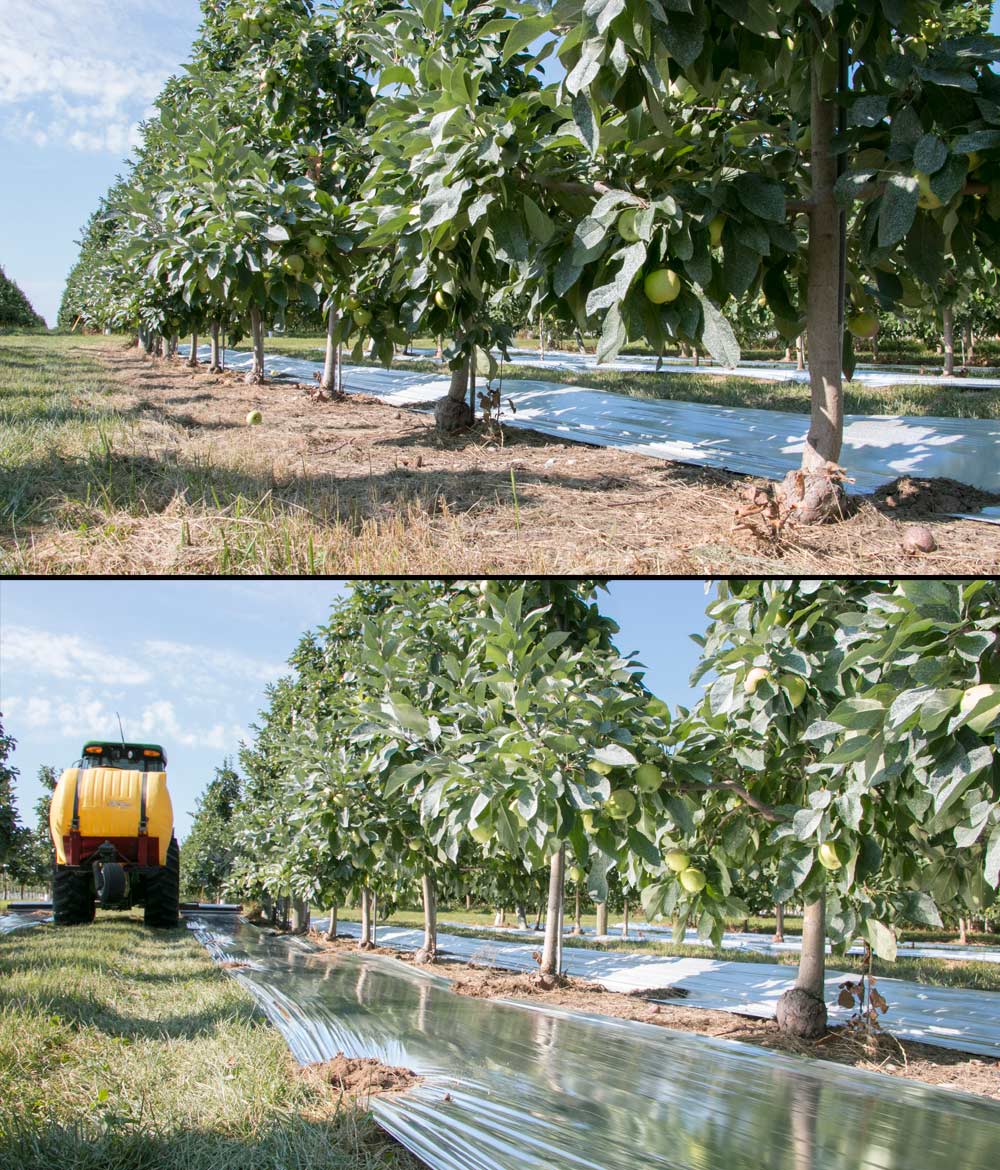
Employees at Tom Rasch & Son demonstrate the use of their automated color fabric roller during the International Fruit Tree Association’s Summer Tour near Grand Rapids, Michigan, in July. The family worked with a local equipment manufacturer to build rollers that attach to weed sprayer booms. (Ross Courtney/Good Fruit Grower)
As consumers increasingly buy apples by color, and as Michigan growers continue to shift to the fresh market, growers there have been experimenting more with reflective fabric to get light to fruit on the bottoms of trees.
Traditionally, fabric is laid by hand in Michigan in what is a three-person job, but at least one grower family is working to automate the process — a task that hasn’t come without challenges.
Kyle Rasch’s early attempts at an automated color-fabric roller involved a discarded trampoline. “It was not ideal,” said Kyle, 25, a third-generation grower in Greenville, Michigan, northwest of Grand Rapids. “We could do only one row at a time, and it was a slow process, but it did the job.”
The Rasches had seen a few custom-built pieces of equipment, but little on the market for the task. So, Kyle used the U-shaped leg from his wind-battered childhood trampoline as an axle to hold a roll of reflective color fabric like a paper towel roll holder in a kitchen.
He attached that to the hydraulic weed-spraying booms on the family’s tractor, along with a spring to hold it tight against the tree trunks. “We took some duct tape, some zip strips and made a little farmer apparatus,” he said.
He and his family liked the results, so they worked with their equipment vendor, which manufactured two rollers that fasten to the sprayer booms, the arms of which fold up and extend to allow them to lay fabric on both sides of the alley at once.
They prefer leaving exposed ground in the middle of the alley to allow access for people and equipment.
The family demonstrated the use of the rollers in July at the International Fruit Tree Association’s Summer Tour.
It’s still a three-person job — one to drive the sprayer, the others to shovel small piles of dirt on the stretched fabric to hold it in place. They consider the rollers a cheap improvement to speed up the job — less than $1,000 for each adapter that holds up to 40-inch rolls on each side.
Reflective material itself, common in Washington state, is pretty new in Michigan, said Phil Schwallier, a Michigan State University extension horticulturist.
Midwest sunlight is typically more diffuse to spread light more evenly, while up until 10 years ago, growers produced primarily apples destined for the processing market, where color doesn’t matter.
These days, the climate has been changing to make color inconsistent, while growers have been converting to high-value fresh varieties like Honeycrisp and SweeTango.
Typically, in Michigan, growers lay strips only under the trees to leave access to the orchard alleys that get muddier than in Washington.
The machine speeds things up, but stretching foil by hand is a relatively easy chore, Schwallier said.
“It’s really not that bad,” he said. Just thread a rope through the roll. One person pulls it and walks backward while two people shovel. That method covers only one row at a time, so the machine doubles the pace of work and eases the stress on workers’ backs.

Top, notice the shade at the bottom of the canopy before color fabric on the Rasches’ SweeTango block. Bottom photo, the reflective strips deliver sunlight to the bottom of the canopy, improving packouts by 10 to 15 percent for the Rasches. (Ross Courtney/Good Fruit Grower)
The Rasches believe in their foil results. Last year, they stretched fabric on about 5 acres and noticed packouts increased 10 to 15 percent from those trees, said Tom Rasch, Kyle’s father. “This is from the sun reflecting in and giving the fruit a better background color,” he said.
The reflection material also ripened their fruit more uniformly, allowing them to pick as much as 70 percent in the first pass.
“We’re really impressed with what we’ve seen so far,” he said.
Studies elsewhere by the Washington Tree Fruit Research Commission also have shown reflective fabric to increase fruit size and yield.
This year, the Rasches are expanding to 15 or 20 acres of SweeTango, Honeycrisp and some of their harder-to-color Galas.
The Rasches advised growers to use caution with the fabric — put it out during a heat wave and you could sunburn the fruit on the bottom. Instead, they try to stretch on a relatively cool day to let the fruit build up a little sun tolerance before the hot weather arrives.
Tom Rasch next hopes to work with the equipment company to add a disc to furrow dirt on top of the fabric automatically, cutting down on labor even more. (Mount Adams Orchard Co. in Oregon and Washington has developed a similar implement.
For more information, see the Nov. 26, 2014, Good Fruit Grower article, “Mylar machine moves fast.”) •
-by Ross Courtney






Really remarkable. Thanks for sharing with us.